Lim Sio Hui finds out how an ambitious new offering at Marina Square shopping mall aims to put a fun, fresh spin on Japanese F&B.

October 28th, 2015
Top image: Emporium Shokuhin – Vino Seafood Wine Bar
After a successful run as Chief Executive of Shin Group heading Japanese chain restaurants such as Shin Kushiya and Kiraku, restaurateur Lim Li Wei is back with a bigger, bolder ambition: bringing together eight new-to-market dining concepts with a strong cross-pollination of themes and resources, and passing savings down to the consumer, most notably through the sale of produce and ingredients.
Conceptualised jointly by Designscape Architects and Wallflower Pte Ltd, Emporium Shokuhin’s design is all about its produce and products, too – the team’s aim was to entice and inspire customers to go on a culinary journey. “You may not cook but you see the food, try it, like it, and want to buy it. It also allows you to savour different kinds of cooking styles,” explains Koh Choon Ngee, partner at Designscape Architects.
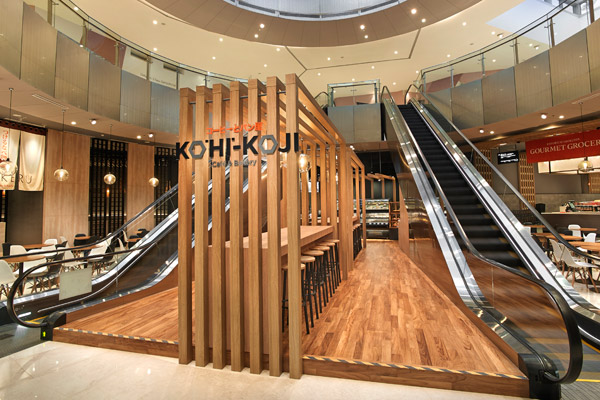
Emporium Shokuhin – Kohi-Koji Cafe & Bakery
The designers carved out the 34,000-square-foot space by taking what was originally a corridor at Marina Square shopping mall and transforming it into what Koh describes as a ‘Japanese streetscape’, where produce and other food-related products are put on display and the visitor can get a peek into different Japanese eateries along the way.
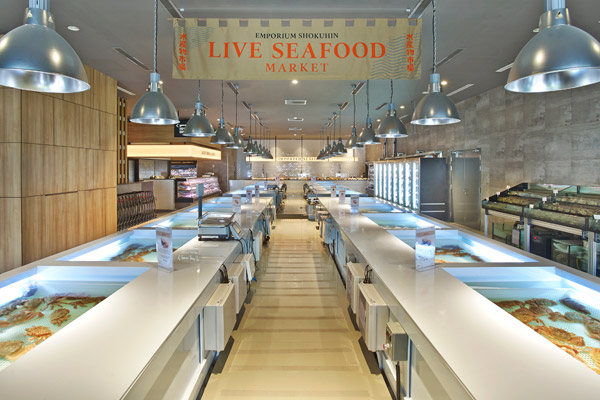
Emporium Shokuhin – Gourmet Grocer
The space is anchored by an 11,000-square-foot gourmet grocer section: upon entering Emporium Shokuhin – Gourmet Grocer, one is greeted by a cavernous live seafood market hall with 22 specially-designed tanks carrying a cubic ton of sea water, from which customers can browse and select from over 20 types of live fish and shellfish.
Freshness is a key emphasis: the design was aimed at projecting and reinforcing the fresh produce, without looking and feeling like a traditional wet market. Arranged neatly in two rows, the open tanks allow customers to get up close to the live seafood, looking down from above.
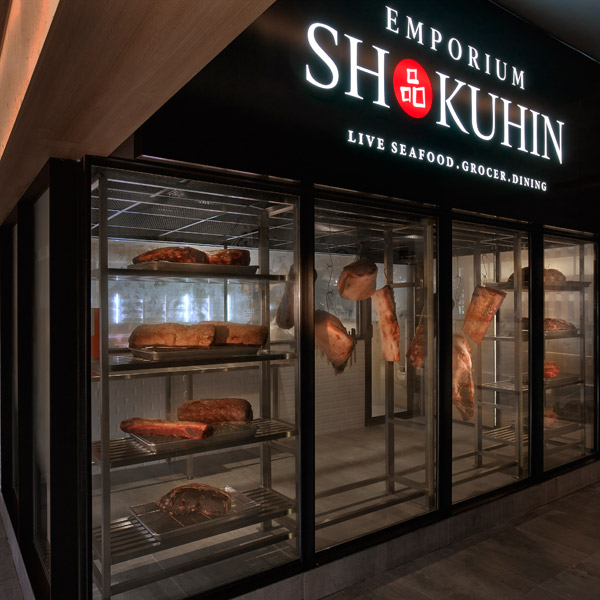
Emporium Shokuhin – Gourmet Grocer, aged beef facility
Likewise, at the customised temperature- and humidity-controlled facility for aged beef, customers can enjoy a front-row view of the tantalising meats displayed prominently in a glass-encased room. “Most supermarkets focus on selling products and not the interior design, but that unfortunately means that the products don’t have the distinction of being special,” shares Wallflower’s Interior Consultant Cecil Chee.
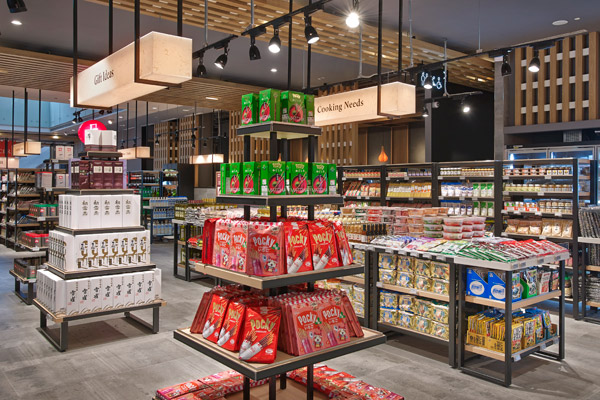
Emporium Shokuhin – Gourmet Grocer
Also stepping away from the mould, the Gourmet Grocer exudes a homely ambiance with warm lighting and sections demarcated by sleek lightboxes textured with the look of Japanese Washi paper. Low, open shelving take the place of the tall, overcrowded aisles of the traditional supermarket, giving added value to the products.
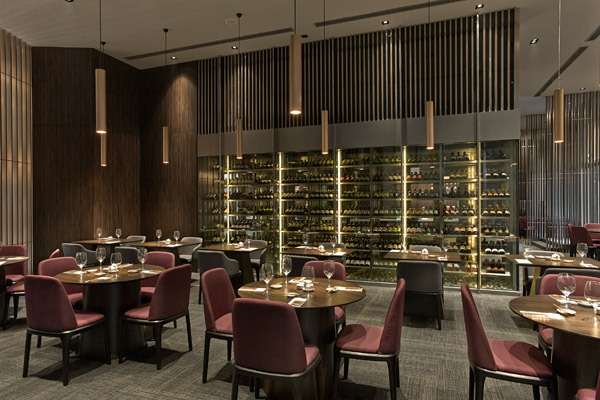
Emporium Shokuhin – Takujo Fine Dining
After whetting the appetite, the visitor is presented with the seven eateries to choose from, but that was also the biggest design challenge, says Chee. “As much as we wanted separate identities for each of them, there had to be something to tie them together. The challenge was in achieving a good balance.”
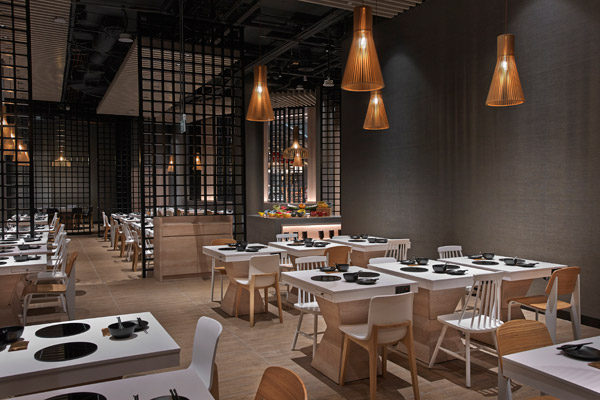
Emporium Shokuhin – Tsukeru Shabu-Shabu
Unifying the design is a palette of muted neutrals that bring out the Japanese flavour of the emporium. This is reflected in the light pine furniture and screens, grey stone accents and flooring. The elements, however, are used in different proportions in each establishment: Tsukeru Shabu-Shabu opens up the space with predominantly white dining arrangements and open trellis, while Burosu Honten’s gyoza and ramen is served in private booths that exude an earthy atmosphere.
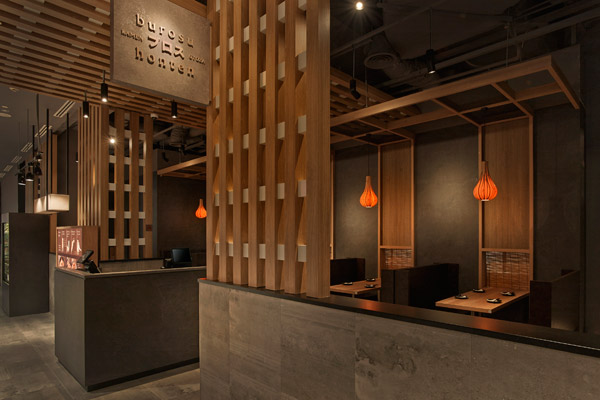
Emporium Shokuhin – Burosu Honten
Chee advocates this rule of thumb: “the concept must stand on its own… it should have its own identity in case the owner wants to franchise it.”
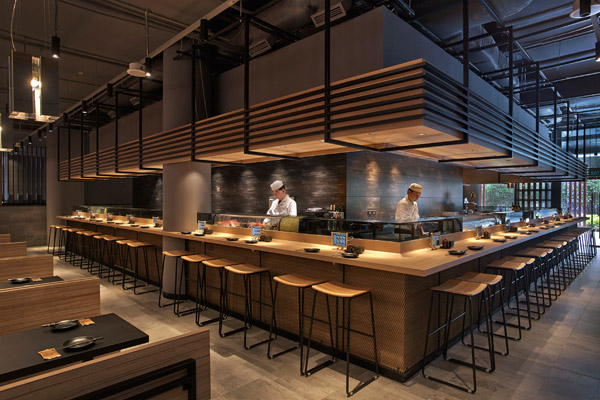
Emporium Shokuhin – Senmi Sushi
Classic Japanese influences such as layering with screens also tie the design together, with subtle but easily recognisable results. “It’s not meant to be trendy, but very classic,” Koh emphasises. “Nobody can put a time stamp on it – it’s relevant now, ten years ago, and even ten years in the future.”
A searchable and comprehensive guide for specifying leading products and their suppliers
Keep up to date with the latest and greatest from our industry BFF's!

In the pursuit of an uplifting synergy between the inner world and the surrounding environment, internationally acclaimed Interior Architect and Designer Lorena Gaxiola transform the vibration of the auspicious number ‘8’ into mesmerising artistry alongside the Feltex design team, brought to you by GH Commercial.

Channelling the enchanting ambience of the Caffè Greco in Rome, Budapest’s historic Gerbeaud, and Grossi Florentino in Melbourne, Ross Didier’s new collection evokes the designer’s affinity for café experience, while delivering refined seating for contemporary hospitality interiors.

Marylou Cafaro’s first trendjournal sparked a powerful, decades-long movement in joinery designs and finishes which eventually saw Australian design develop its independence and characteristic style. Now, polytec offers all-new insights into the future of Australian design.

Sub-Zero and Wolf’s prestigious Kitchen Design Contest (KDC) has celebrated the very best in kitchen innovation and aesthetics for three decades now. Recognising premier kitchen design professionals from around the globe, the KDC facilitates innovation, style and functionality that pushes boundaries.
The internet never sleeps! Here's the stuff you might have missed

Adaptive reuse is all the rage across the design industry, and rightly so. Here, we present a selection of articles on this most effective approach to sustainability.

With Milan 2024 only a few weeks away, we sneak a view of some of the most exciting pieces set to go on show – from lighting design to furniture, here are nine preview products.